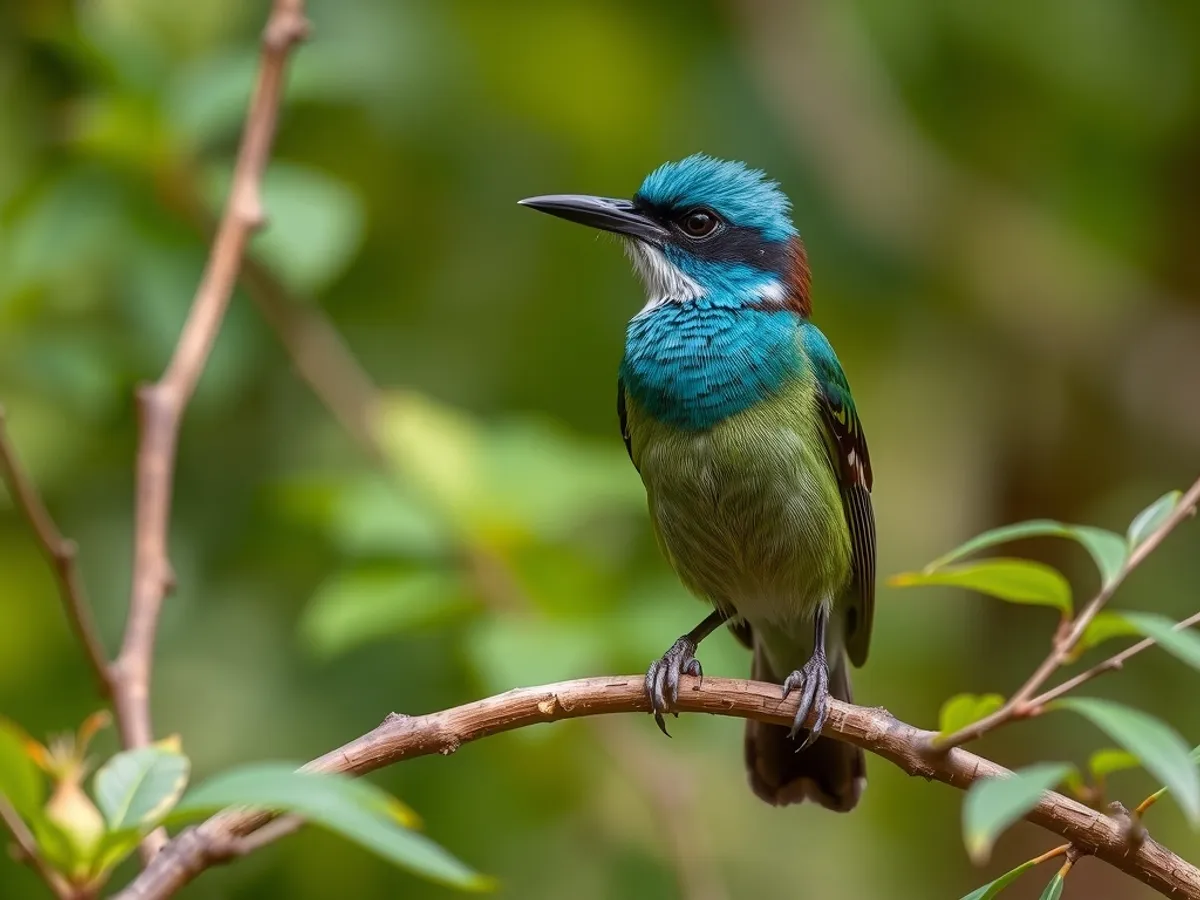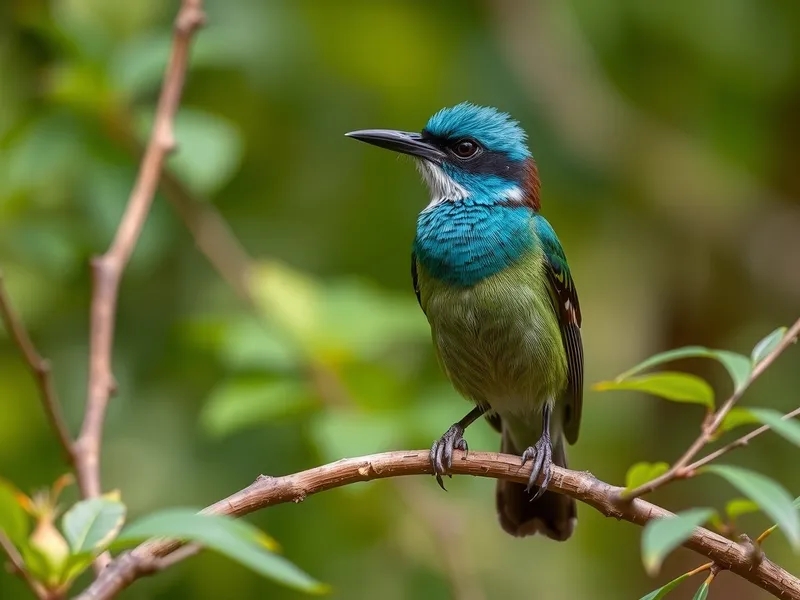
Turquoise-browed Motmot
Eumomota superciliosa

Meet the Turquoise-browed Motmot
The Turquoise-browed Motmot is a strikingly colorful bird known for its vivid turquoise and green plumage, rufous back, and unique racket-shaped tail feathers. Native to Central America, it is commonly found in open woodlands, forest edges, and scrublands. This species is easily recognized by its bright turquoise eyebrow and long, bare-shafted tail with paddle-like tips. The Turquoise-browed Motmot is often seen perched quietly, swinging its tail like a pendulum, which is believed to be a form of communication.
Classification
Bird
Habitat
Open woodlands, forest edges, and scrublands
Diet
Omnivore
Lifespan
8-12 years
Conservation
Least Concern
Weight
65-70 grams
📖Fascinating Facts
Unique Tail Feathers
The Turquoise-browed Motmot’s tail has bare shafts ending in paddle-like tips, which form naturally and give the bird a distinctive appearance.
Ground Nester
Unlike many birds, it nests in burrows dug into banks or road cuts, providing protection for its eggs and chicks.
National Symbol
This species is celebrated as the national bird of both El Salvador and Nicaragua, symbolizing beauty and freedom.
📋Detailed Description
The Turquoise-browed Motmot (Eumomota superciliosa) is a medium-sized bird, measuring approximately 34–38 cm (13–15 in) in length, with males and females similar in appearance. Its most distinctive features are the vibrant turquoise supercilium (eyebrow), greenish-blue crown, and elongated central tail feathers ending in racquet-shaped tips, which are formed by the birds preening away barbs from the shaft. The plumage is a striking combination of green, blue, and rufous, with a black mask across the face and a bright turquoise patch on the wings. The bill is strong, slightly decurved, and black, adapted for catching a variety of prey. The eyes are large and dark, providing excellent vision for spotting prey from open perches. The legs are short and adapted for perching rather than walking. Motmots are known for their unique tail-wagging display, swinging the tail back and forth like a pendulum, which is thought to serve both in communication and as an anti-predator signal. This species is diurnal and most active during the early morning and late afternoon. It is relatively tolerant of human presence and often seen in disturbed habitats, such as roadsides and gardens, as well as natural forest edges.
💡 Did you know?
Unlike most birds, the Turquoise-browed Motmot's tail feathers naturally lose barbs near the tip, giving them their unique racket shape without the bird needing to preen them into form.
🔬Research & Sources
Wikipedia Summary
The turquoise-browed motmot is a colourful, medium-sized bird of the motmot family, Momotidae. It inhabits Central America from south-east Mexico, to Costa Rica, where it is common and not considered threatened. It lives in fairly open habitats such as forest edge, gallery forest and scrubland. It is more conspicuous than other motmots, often perching in the open on wires and fences. From these perches it scans for prey, such as insects and small reptiles. White eggs (3–6) are laid in a long tunnel nest in an earth bank or sometimes in a quarry or fresh-water well. Its name originates from the turquoise color of its brow. It is the national bird of both El Salvador and Nicaragua, where it is known as torogoz and guardabarranco respectively.
Last Modified: 5/25/2025
🎭Behavior & Social Structure
Turquoise-browed Motmots are primarily solitary or found in pairs, though small family groups may form during the breeding season. They are sit-and-wait predators, spending long periods perched in the open, scanning for prey such as large insects (beetles, grasshoppers, butterflies), spiders, and occasionally small reptiles or amphibians. When prey is spotted, they swoop down to capture it with their bill, returning to the perch to consume it. They may also supplement their diet with fruit, especially during the dry season when insect prey is less abundant. The species is territorial, with pairs defending nesting and foraging areas through vocalizations and tail displays. Their vocal repertoire includes a series of low, guttural calls and sharp 'motmot' notes, which serve in mate communication and territory defense. The characteristic tail-wagging display is used in both social interactions and as a deterrent to predators, signaling alertness and fitness.
👶Reproduction & Life Cycle
Breeding occurs during the dry season, typically from March to June, coinciding with increased food availability. Turquoise-browed Motmots are monogamous, forming long-term pair bonds. Courtship involves mutual preening, feeding, and synchronized tail displays. Both sexes excavate a long, horizontal tunnel (up to 1.5 meters) in an earth bank, road cut, or sometimes in man-made sites like quarries or wells. The nest chamber at the end of the tunnel is unlined. The female lays 3–6 glossy white eggs, which are incubated by both parents for about 20–21 days. After hatching, both parents feed the chicks, bringing them insects and small vertebrates. The nestlings fledge after approximately 28–30 days but may remain dependent on the parents for several weeks. High nest predation rates are common, especially from snakes, mammals, and other birds.
🛡️Adaptations & Survival
The motmot's distinctive tail, with its bare shaft and racquet tips, is a unique adaptation among birds. The tail display is believed to function in mate attraction and predator deterrence (the 'pursuit-deterrent' hypothesis), signaling to predators that the bird is alert and not easily caught. Their cryptic nest placement in tunnels protects eggs and chicks from many predators and environmental extremes. The strong, decurved bill allows them to handle a wide variety of prey, while their excellent vision aids in detecting movement from a distance. Their tolerance of open and disturbed habitats is an ecological adaptation that allows them to thrive in both natural and human-modified landscapes.
📚Research Sources
🎨Cultural Significance
The Turquoise-browed Motmot holds significant cultural importance in Central America. It is the national bird of both El Salvador (where it is called 'torogoz') and Nicaragua ('guardabarranco'), symbolizing beauty, freedom, and the natural heritage of these countries. The bird features in local folklore and is often depicted in art, crafts, and currency. Its distinctive appearance and behavior have made it a subject of admiration and a symbol of environmental conservation efforts in the region.
🔬Recent Research & Discoveries
Recent studies have focused on the function of the motmot's tail-wagging display, supporting the idea that it serves as a pursuit-deterrent signal to predators. Genetic research has clarified its phylogenetic position within the Momotidae family, confirming Eumomota as a monotypic genus. Ongoing research includes the impact of habitat fragmentation on breeding success and the effects of climate change on distribution and phenology. Citizen science projects and bioacoustic monitoring are contributing valuable data on population trends and vocal behavior.
🎥Wildlife Videos

History & Secrets of the Turquoise-browed Motmot | Evolution INSIGHTS
Discover the captivating story of the Turquoise-browed Motmot (Eumomota superciliosa) — a brilliantly colored bird native to ...
Evolution INSIGHTS

torogoz: El ave reloj - documental de animales salvajes
Algunas aves son tan hermosas e impresionantes, que los países que las albergan las convierten en sus aves nacionales, uno ...
Cityanimal

Top 10 Most Captivating Green Birds in Nature | Stunning Footage & Fun Facts!
Explore the top 10 most captivating green birds in nature, featuring stunning footage and fun facts. Discover the beauty and ...
Winged Wonders: Fascinating World of Birds

11 amazing Green colored Birds
11 amazing Green colored Birds These green-colored birds may not be as colorful and beautiful than green-colored parrots, ...
List of Animals

Top 12 Beautiful and Rare Birds
Top 12 Beautiful and Rare Birds Chances are you've probably never seen some of the rarest birds in the world and you are not ...
List of Animals

Exotic Rufous Motmot SONGBIRDS That Will Blow Your Mind!
The sound of exotic Rufous Motmot - Songbirds - Exotic Birds. The Rufous Motmot is a large (approx 16.5 In) exotic looking bird ...
Birds & Sounds of Nature
🌍Habitat Information
The Turquoise-browed Motmot typically inhabits Open woodlands, forest edges, and scrublands environments. Turquoise-browed Motmots have adapted to their environments with specialized features and behaviors.
Primary Habitat:
Open woodlands, forest edges, and scrublands
More detailed habitat information will be available soon.
🛡️Conservation Status
The Turquoise-browed Motmot is currently classified as Least Concern. Conservation efforts are crucial for preserving this species for future generations.
Common Threats:
- 🏠Habitat loss and fragmentation
- 🌡️Climate change impacts
- 🎯Hunting and poaching
- 🏭Human-wildlife conflict
⚠️Threats & Conservation Challenges
Currently classified as Least Concern by the IUCN, the Turquoise-browed Motmot maintains stable populations across its range. However, localized threats include habitat loss from agricultural expansion, urbanization, and road construction, which can destroy nesting banks. Pesticide use may reduce insect prey availability. In some areas, nest predation rates are high, and human disturbance near nesting sites can lead to abandonment. Despite these challenges, the species' adaptability to open and disturbed habitats has allowed it to persist in many areas where forest cover has been reduced.
🔬Scientific Classification
Scientific Name
Eumomota superciliosa
Classification Hierarchy
🔍 About Taxonomic Classification
Taxonomic classification is a hierarchical system used by scientists to classify and organize living organisms based on shared characteristics and evolutionary relationships.
The system moves from broad categories (Kingdom) to increasingly specific ones, with each animal's scientific name typically consisting of its Genus and species.
📝Community Notes
Share your observations and insights about the Turquoise-browed Motmot with our community of wildlife enthusiasts.
Join Our Community
Sign in to share your observations and connect with fellow wildlife enthusiasts.
Sign In to ContributeNo community notes yet
Be the first to share your observations about the Turquoise-browed Motmot!
Explore Turquoise-browed Motmot
Select a tab above to learn more about this amazing animal.
📸Photo Gallery
No photos available for this animal yet.
🌟Discover More Wildlife
Continue your journey of discovery with more fascinating animals from our database
